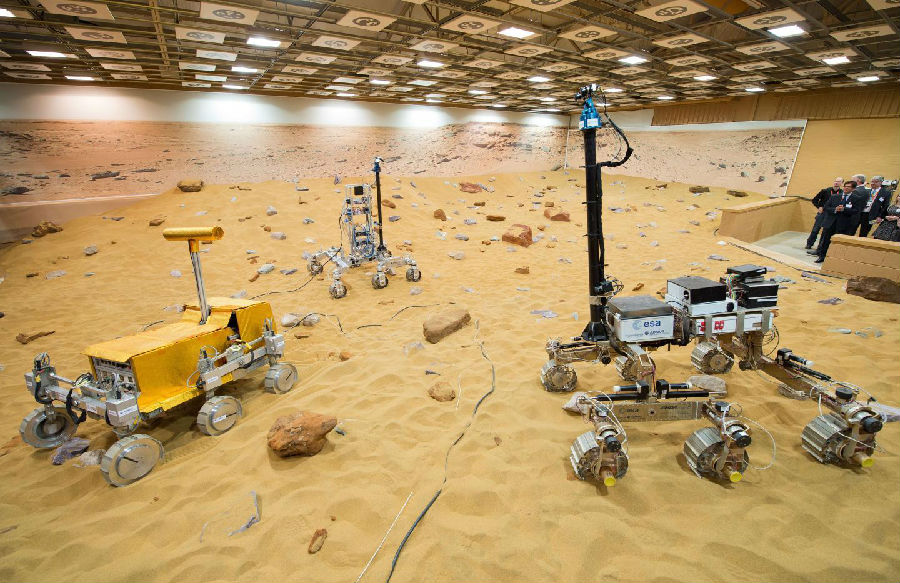Slowly rolling across specially dried sand at the Airbuses testing site in Stevenage, north of London,
在伦敦以北的斯蒂夫尼奇空客试验场,它正慢慢滚动在特制干沙上,
the ExoMars rover is proving that its wheels can easily conform to the shape of rocks.
ExoMars探测器正在证明它的轮子可以轻而易举地踏过岩石。
There's a good reason why they are not made of rubber says ESA's mechanical engineer Abbie Hutty.
欧洲航天局机械工程师阿比·赫蒂说,不用橡胶轮子是有原因的。
We don't want to take anything that's organic from Earth with us.
我们不想携带地球上的任何有机物质。
So we've managed to create this wheel that's fully flexible but made out of effectively a membrane,a spring, of metal.
这种轮子非常灵活,它由金属薄膜,金属圈制作而成。
The ExoMars Rover project, developed by ESA and the Russian space agency Roscosmos,
ExoMars探测器项目是由欧洲航天局和俄罗斯联邦航天局共同开发,
will be the first specifically dedicated to search for signs of life.
它将成为首个专门用来探寻生命迹象的项目。
All missions up to now have only dug the top five centimeters of the surface.
目前所有的任务只是挖到地表5厘米处。
And we will go down to two meters. This is very important because it is in the subsurface and that depth
我们将挖到地下2米,这非常重要,因为是在地下和更深的地方,
that we have the best chance of finding evidence for the possible past presence of life on Mars.
我们也就更有可能在火星找到生命出现过的证据。
Mars has almost no atmosphere to shield it from extreme temperatures,
火星几乎没有大气层来保护它不受极端温度的影响,
ranging from minus 100 degrees centigrade at night to plus 90 degrees at noon.
气温变化可从晚上的零下100摄氏度到中午的90度。

It also does not have a magnetic field like Earth's, which blocks cosmic radiation, so life as we know it, couldn't survive on its surface.
它也没有像地球一样阻挡宇宙辐射的磁场,所以据我们所知,生命无法在其表面生存。
Down below different layers of rocks, maybe in a fissure between two different layers of rocks
在不同岩石层下面,或许在不同岩石层的裂缝中,
where there's water deposits and that kind of thing that could be a nice place for that life to still be surviving.
或许会有水沉积下来,等等这些物质,这里有可能有生命存在。
The lack of a magnetic field presents another challenge. A compass does not work on Mars.
没有磁场也会出现另外一个问题,指南针在上面起不了作用。
At a distance of 54 million kilometers from Earth, combined with the planet's rotation
火星距离地球5400万公里,再加上行星的自转,
that makes driving the rover remotely, a fairly complex task.
使得远距离操控探测器是一项相当复杂的任务。
So while it's just on its own on the planet surface, if it can look at what's in front of it,
火星上只有探测器,如果它能够看到前方的事物,
decide where it's got to go, how it's gonna pick its path safely through that and drive all by itself,
决定往哪里走,如何选择安全的道路行进,自主行驶,
you can do a lot more science during the lifetime of the rover.
那么在它的使用寿命里,它能够做大量科研工作。
Scientists say once it lands safely on Mars, the ExoMars rover will be able to travel up to 100 meters per day,
科学家称一旦在火星上安全着陆,它每天可以行进100米,
drilling the soil and looking for signs of life.
钻探土壤,寻找生命迹象。
George Putic, VOA news
VOA新闻,乔治·普蒂克报道。


